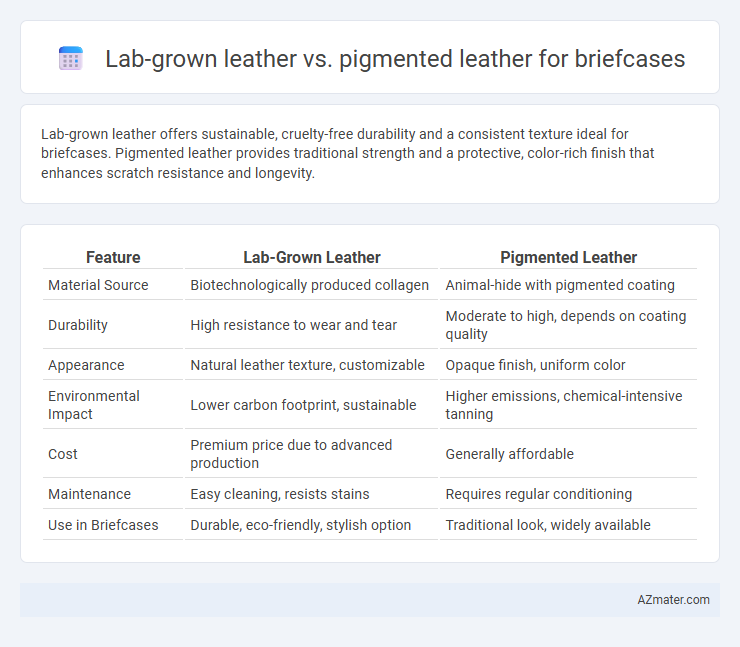Lab-grown leather offers sustainable, cruelty-free durability and a consistent texture ideal for briefcases. Pigmented leather provides traditional strength and a protective, color-rich finish that enhances scratch resistance and longevity.
Table of Comparison
| Feature | Lab-Grown Leather | Pigmented Leather |
|---|---|---|
| Material Source | Biotechnologically produced collagen | Animal-hide with pigmented coating |
| Durability | High resistance to wear and tear | Moderate to high, depends on coating quality |
| Appearance | Natural leather texture, customizable | Opaque finish, uniform color |
| Environmental Impact | Lower carbon footprint, sustainable | Higher emissions, chemical-intensive tanning |
| Cost | Premium price due to advanced production | Generally affordable |
| Maintenance | Easy cleaning, resists stains | Requires regular conditioning |
| Use in Briefcases | Durable, eco-friendly, stylish option | Traditional look, widely available |
Introduction: The Rise of Alternative Leathers for Briefcases
Lab-grown leather offers a sustainable and eco-friendly alternative to traditional pigmented leather in briefcase manufacturing, reducing environmental impact while maintaining durability and aesthetic appeal. Pigmented leather, known for its rich color and protective coating, provides long-lasting wear but often involves chemical treatments that raise ecological concerns. The rise of alternative leathers like lab-grown variants reflects a growing consumer demand for ethically produced, high-quality materials in luxury briefcases.
What Is Lab-Grown Leather?
Lab-grown leather, also known as cultured leather, is produced by cultivating animal cells in a lab environment, creating a sustainable alternative to traditional pigmented leather derived from animal hides. This innovative material offers precise control over texture, thickness, and color, enhancing durability and reducing environmental impact compared to pigmented leather, which undergoes surface treatment with colored pigments. Lab-grown leather's eco-friendly production process minimizes water usage and chemical waste, making it an increasingly popular choice for premium briefcases aiming for luxury and sustainability.
Pigmented Leather: Traditional Choice Explained
Pigmented leather remains the traditional choice for briefcases due to its durable, uniform coating that provides excellent resistance to scratches, stains, and fading over time. This leather type features a pigmented top layer that enhances color consistency and surface protection, making it ideal for daily use and maintaining a polished appearance. Despite emerging alternatives like lab-grown leather, pigmented leather's proven longevity and reliable performance continue to dominate the craft of high-quality briefcase production.
Production Process: Lab-Grown vs Pigmented Leather
Lab-grown leather is produced through a biotechnological process that cultivates collagen fibers from animal cells in a controlled environment, resulting in a sustainable and animal-free material. Pigmented leather undergoes traditional tanning and dyeing methods where animal hides are treated with pigments and coatings to achieve color and durability. The lab-grown process emphasizes reduced environmental impact and resource efficiency compared to the more resource-intensive and chemical-reliant production of pigmented leather.
Durability and Longevity Comparison
Lab-grown leather offers superior durability due to its engineered fibers designed to resist wear and tear, maintaining structural integrity over extended use. Pigmented leather, treated with surface coatings, provides enhanced resistance to scratches and stains but may show signs of cracking and fading over time. Briefcases made with lab-grown leather typically demonstrate longer lifespan and consistent appearance compared to pigmented leather counterparts.
Aesthetic Appeal: Texture and Color Differences
Lab-grown leather offers a smooth, consistent texture with customizable color options, resulting in a sleek and modern aesthetic for briefcases. Pigmented leather features a durable surface finish with a slightly matte or glossy appearance, often showing natural grain patterns that add character and depth. While lab-grown leather provides uniformity and vibrant hues, pigmented leather maintains a classic, rich look with subtle texture variations enhancing its visual appeal.
Environmental Impact: Sustainability Considerations
Lab-grown leather significantly reduces environmental impact by minimizing land use, water consumption, and greenhouse gas emissions compared to traditional pigmented leather, which relies on resource-intensive livestock farming and chemical tanning processes. Sustainable production of lab-grown leather leverages biotechnology to create animal-free materials with lower carbon footprints and reduced toxic waste. Pigmented leather often involves hazardous dyes and chemical finishes that contribute to pollution, whereas lab-grown alternatives present a cleaner, eco-friendly solution for briefcase manufacturing.
Cost Analysis: Investment and Value Over Time
Lab-grown leather offers a higher initial investment compared to pigmented leather due to advanced manufacturing processes but promises greater durability and resistance to wear, potentially lowering long-term replacement costs for briefcase owners. Pigmented leather, while more affordable upfront, may require frequent maintenance and replacement, increasing total expenditure over time. Evaluating the life cycle cost reveals lab-grown leather as a cost-effective solution by combining sustainable production with extended product lifespan.
User Experience: Comfort and Practicality
Lab-grown leather offers enhanced comfort by being more flexible and breathable compared to pigmented leather, which can feel stiffer and less forgiving over time. Its non-toxic, hypoallergenic properties improve user experience by reducing skin irritation, making it ideal for daily use in briefcases. Practicality is increased through superior resistance to cracking and easier maintenance, extending the briefcase's lifespan without compromising aesthetics.
Which Leather is Best for Briefcases? Final Thoughts
Lab-grown leather offers enhanced sustainability and consistent texture, making it an excellent choice for eco-conscious consumers seeking durability in briefcases. Pigmented leather provides superior stain resistance and color retention, ensuring a polished appearance over time with minimal maintenance. For briefcases, the best leather depends on your priorities: choose lab-grown leather for environmental benefits and ethical production, or pigmented leather for traditional durability and a long-lasting, uniform finish.

Infographic: Lab-grown leather vs Pigmented leather for Briefcase
 azmater.com
azmater.com